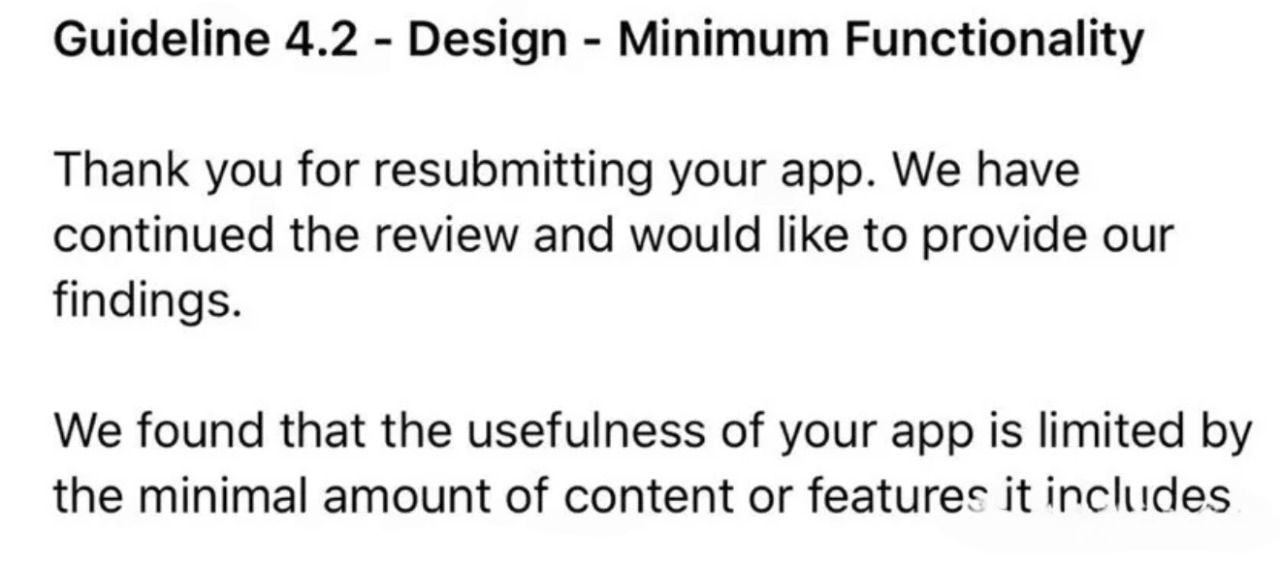- Blog
- Self-Rescue for Apple Developer Review: Curing the Stubborn 4.2 Issue
Self-Rescue for Apple Developer Review: Curing the Stubborn 4.2 Issue

Compared to 4.3, the 4.2 rejection is relatively easier to deal with. For developers who pursue a minimalist product style, it might require finding a better balance.
4.2 essentially refers to the Minimum Functionality requirement — meaning the reviewer thinks your app’s features are too simple and doesn't meet the standards expected for App Store release.
This reason is obviously subjective. What counts as "too simple"? Why are there apps ten times simpler than mine that get approved? Many developers wonder this. However, it’s generally not a good idea to directly challenge Apple; most likely, you’ll just get a canned response like:

“Thank you for your feedback. We still believe your app offers limited functionality for a full App Store experience.”
Feeling frustrated? On the verge of despair?
Don’t panic. When you encounter a 4.2 rejection, the first step is to carefully review the specific reason given.
In general, 4.2 issues fall into a few categories:
The app looks overly simplistic: The reviewer glances at your app and sees only one or two very basic features, deeming it too bare-bones for approval.
Suspected web wrapper: Your app gets flagged by automated tools or the reviewer suspects it’s just a basic web view pretending to be a native app.
Non-functioning buttons or missing features: For example, if you have social login options like QQ, WeChat, or Weibo, and the reviewer doesn’t have those apps installed, login buttons might appear broken.
You need to respond differently based on the situation:
For the first case, if your app actually has depth but the reviewer missed it, immediately respond through App Store Connect. Use detailed explanations, preferably with screenshots or videos, to highlight your app’s features and value.
For the second case, if you really are submitting a web wrapper, it’s hard to argue. But if not, explain clearly that your app is truly native and point out its native functionality.
For the third case, fix the logic. Make sure social login buttons are hidden if the apps aren’t installed, or show a friendly pop-up explaining what’s happening.
Even if you address these issues, 4.2 might stick around. It’s like a stubborn skin disease — not fatal, but endlessly annoying.
So, what else can you do? You may need to make deeper code-level changes and resubmit. Unlike 4.3, 4.2 usually doesn’t delay review timelines much, so with careful communication and patient iteration, you will eventually pass. Here's a summary of strategies for handling 4.2:
Always respond to rejections: If possible, politely and thoroughly explain your app’s features. If reviewers start providing screenshots in their feedback, this is a positive sign — they’re opening the door for you to fix the problem.
Leverage native iOS features: Integrate system-level features like push notifications, 3D Touch, widgets, etc. These strongly prove your app isn’t just a web wrapper.
Add multiple navigation layers: If your app only has one or two screens, reviewers may feel it’s "too simple". Designing a few more secondary pages helps avoid this perception.
Use smooth UI transitions and animations: Subtle animations like fade-ins, slides, or transitions on your landing page give the impression of a well-crafted, original product.
Incorporate your 2.0 roadmap features early: 4.2 often hits brand-new apps where the initial feature set is still small. Accelerating your future plans into the current version shows proactive growth, which Apple appreciates.
If you follow the above advice when revising and resubmitting, you’ll be much closer to overcoming 4.2 and getting your app approved!

